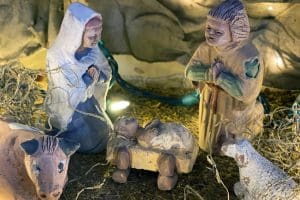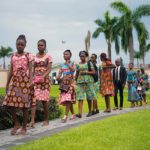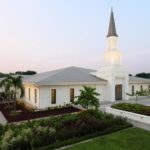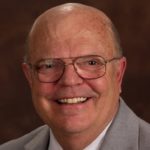![]()
America‘s Hope
By Douglas E. Brinley
Chapter 2 – America, the Promised Land
Editor’s Note: Several civilizations lived on the American continent over the centuries, and each of them was eventually decimated or destroyed. Does a similar fate await us? Author Douglas E. Brinley describes ten stages of decline through which all of the previous societies passed through before they were destroyed, and he compares our current circumstances to theirs. His book, serialized here, provides insights that give us hope in a time of upheaval, and offers timely counsel on what we must do to avoid the fate that befell former civilizations.
The Americas – north and south – have been promised lands since creation’s dawn. God has preserved these continents as a haven for the righteous (Ether 13:2). Latter-day scriptures have much to say about the past, present, and future of this geographical area, more particularly the area that is now the United States of America. This nation, specifically, occupies a land of destiny, a land that has been reserved and preserved by the Lord as a “base of operations” from which the gospel would be carried worldwide in this final dispensation.
Nevertheless, if the inhabitants of this land become careless, forget or ignore God, His laws, and His servants, and allow wickedness to gain a foothold to the extent that evil prevails, the land then loses its divine protection and instead becomes a land of war and calamity.
The Americas have been home to at least four different civilizations:
1. Antediluvians – those who lived on the land before the flood of Noah’s day. This civilization began with Adam and Eve and continued with their posterity, including Enoch and his city, down to the time when all but eight souls were swept from the earth in a great deluge.
2. Jaredites – a colony that came to this land in eight barges soon after the Tower of Babel incident in biblical times, possibly 2200 to 2100 b.c. “Jared came forth with his brother and their families, with some others and their families, from the great tower, at the time the Lord confounded the language of the people” (Ether 1:33).
This colony was given the following promise: “There shall be none greater than the nation which I will raise up unto me of thy seed, upon all the face of the earth” (Ether 1:43). How sad that this civilization, which began with such a great promise, was destroyed when the people were fully ripe in iniquity. Only two survivors – Coriantumr, the king of the Jaredites, and Ether, the prophet of the Lord – survived the great desolating civil war. Coriantumr lived long enough to be found by the people of Mulek, and he dwelt among them until his death (Omni 1:21-22). The Jaredites may have remained on the land as late as 300 b.c.
3. Lehites and Mulekites – two groups from the Jerusalem area came to the Americas around 588 b.c. Though contemporaries, they came in different migrations. In time the Nephites discovered the people of Zarahemla, or Mulekites, and the two united about 300 b.c. during the reign of King Mosiah (Omni 1:14-19). The Nephite nation eventually ripened in iniquity, and those who would not deny Jesus Christ or His gospel were eventually annihilated by the Lamanites, who remain scattered throughout the land of the Americas.
4. Gentiles – latter-day people who came to this land in the fifteenth century. Columbus was the first of the Gentiles to reach the promised land (1 Nephi 12:12). After 1492, other Gentiles came to what would later be called America. The Gentiles are the present occupants of the land. Latter-day Saints, despite being a portion of the house of Israel, are also a portion of the Gentiles (D&C 109:60).
As members of the Church, identified as Israel by patriarchal blessings, who live among the Gentiles, we have a responsibility to know and understand the answers to the following basic questions:
- What happened to the earlier inhabitants of this land that caused their demise?
- What must the present occupants know about the covenants and requirements of righteousness demanded by Deity of those who live on this land if they are to remain a free and prosperous people?
- Is it really possible that America, despite its educational progress, technological developments, and free enterprise system, could experience the same fate as the earlier inhabitants?
- Why were the Lamanites spared annihilation?
- What role do Latter-day Saints play in preserving the land and preventing a repetition of the events that led to the destruction of former civilizations?
- Why has America been singled out as a special place for God to initiate “a great and marvelous work” in the last days? (1 Nephi 14:7; D&C 11:1; 12:1; 14:1).
The earlier civilizations were destroyed when they ripened in iniquity. The Antediluvians, Jaredites, and Nephites are long gone. There are no identifiable descendants of these people today except for the Lamanites, who, along with Jews and Gentiles, now reside upon the land. Thus, the title page of the Book of Mormon indicates that the book was “written to the Lamanites … and also to Jew and Gentile.”
A Promised Land
What is a promised land? It is a place of “refuge, a place of safety for the saints of the Most High God” (D&C 45:66). It is a place where righteous individuals gather not only to avoid the calamities that come to the wicked but to worship and wholly serve the Lord with all their heart and mind. It is a land with a political system that allows individuals to create stable families, to build a community of decent, hard working, God-fearing people who “teach one another words of wisdom; [who] seek … out of the best books words of wisdom; [and who] seek learning, even by study and also by faith.” These are people who “organize [themselves and] prepare every needful thing; and establish a house, even a house of prayer, a house of fasting, a house of faith, a house of learning, a house of glory, a house of order, a house of God” (D&C 88:118-19).
Such individuals are anxiously seeking “immortality and eternal life” through the Father’s plan of salvation (Moses 1:39). Such a people are engaged in building the kingdom of God on earth, spreading the knowledge and blessings of the gospel and priesthood to those unaware of the latter-day Restoration, a people grateful for the opportunity to exercise moral agency in an environment of political stability. Such is the plan of God, who told Enoch: “Unto thy brethren have I said, and also given commandment, that they should love one another, and that they should choose me, their Father” (Moses 7:33). In the history of the world, only a few of the Father’s family have chosen the good things of life and eschewed evil.
America, a Place of Zion
The scriptures speak of a latter-day Zion to be “built upon the American continent” (Articles of Faith 10; Ether 13:3, 6), a place where “there shall be gathered unto it out of every nation under heaven; and it shall be the only people that shall not be at war one with another … And it shall come to pass that the righteous shall be gathered out from among all nations, and shall come to Zion, singing with songs of everlasting joy” (D&C 45:69, 71).
The birth of this latter-day Zion began with the restoration of the gospel and the priesthood to Joseph Smith and his associates in the nineteenth century. It came after a long period of spiritual drifting and apostasy that followed the Savior’s ministry, a time when external influences and the philosophies of men combined with internal pressures of church councils to influence men to change divine principles, doctrines, ordinances, and covenants to coincide with the philosophies of men. The valiant efforts of the apostles to take the message of Christianity to the world were polluted by the ideas of men, primarily of Greek and Roman origin. The early disciples of the Lord made valiant efforts to establish branches of the Church of Jesus Christ among the earth’s inhabitants; however, governments at the time were tyrannical, and wicked kings sat upon thrones stained with the blood of martyrs. Sadly, by the end of the first century in the very land where Jesus was born and ministered in mortality, much of the truth that He had taught was lost or severely distorted after His death and that of His apostles.
While an apostasy was going on in that part of the world, a great civilization was flourishing across the ocean in the Americas – the new “promised land.” Unfortunately, this civilization, like its counterpart in the Middle East, eventually ended in apostasy among the Nephites and tribal wars that took place among the surviving Lamanites (Mormon 8:8).
The Lord kept hid from other nations the land of America until it was time to restore His gospel and priesthood in the last days (2 Nephi 1:8). This land was reserved for a work that would stretch across the width and breadth of the earth before the second coming of the Lord Jesus Christ. God raised up men in this latter-day civilization to organize a unique form of government under which people would be free to exercise moral agency and worship God without government interference. Soon after the miracle of independence and the birth of a new nation, the calling of a prophet and the restoration of the gospel and priesthood commenced, allowing the organization of the Lord’s true Church in 1830.
On this land of promise, the Lord established the latter-day nation and then the kingdom of God, which Daniel had foreseen (Daniel 2:44). Settling this new land was difficult for the initial settlers. The Pilgrims, Puritans, and others suffered extreme exposure and hardship, and many died trying to establish a foothold on the land. After a tremendous effort, and no doubt aided by divine intervention, they did it - they survived and, in time, prospered. They forged a new nation with a form of government that gave dignity to man in an environment of religious and political freedom.
The Final Dispensation
At this time in our nation’s history, however, we are beginning to see ominous signs of the very things that destroyed earlier civilizations. Iniquity is becoming more rampant and acceptable despite the seeming blessings of a “soft life” God has given us. Consider the laborsaving devices and marvelous medical and technological breakthroughs of the past two centuries. It is a time of contrast, for the close of the twentieth century, perhaps the bloodiest period of war and devastation in the history of the world, was also a time when civilization moved ahead by leaps and bounds. Two world wars and several deadly skirmishes combined with an unprecedented disregard for human life by leaders in Germany, Russia, and elsewhere who killed millions of innocent people. Of course, modern warfare can kill many more people than was possible in the days of swords, knives, and other primitive weapons.
Our land has been blessed with remarkable advances in science, technology, medicine, education, entertainment, and we are witnesses to a multitude of daily world events through the miracle of satellite, television, and the internet. Personal travel to various destinations on the planet has increased as travel time has been reduced to hours rather than days or months.
The sad counterpoint to this good news is the Lord’s statement to Joseph Smith in 1837 that “darkness covereth the earth, and gross darkness the minds of the people, and all flesh has become corrupt before my face” (D&C 112:23). Wickedness, the Savior told his disciples, would become so prevalent in the latter days that it would rival “the days of Noah” (Joseph Smith – Matthew 1:41), when “every man” was “evil continually” (Moses 8:22).
Yet we also find a promise in the Book of Mormon that “a New Jerusalem should be built upon this land” (Ether 13:6), and that Enoch and his city will return with the Savior to join the righteous inhabitants of the latter-day Zion (Moses 7:62-64). So, an interesting future lies ahead of us. The Lord restored His Church as a part of the preparatory work that will culminate in His return to usher in the Millennium. Latter-day Saints, despite what some may see as dismal prospects, have reason to rejoice in the promises made to the righteous.
America as a Land of Restoration
The Restoration, as Latter-day Saints refer to it, came after a long night of apostasy. And despite attempts at reform by good and sincere men in Great Britain and Europe, it was here, in America, that the Lord restored His Church and priesthood. This is the land where He sent heavenly messengers to return the fulness of the gospel and restore divine authority to administer essential priesthood ordinances and establish His Church. It was on this soil that He inspired men to form a new nation. It was on this territory that mankind could once again exercise agency with minimal government interference in a representative form of political system rare in the earth’s history.
Soon after the founding of this nation, God the Father and His Son Jesus Christ chose to reveal themselves to a young, unsophisticated, and unlettered fourteen-year-old boy, who would declare the principles of salvation and exaltation that had been missing from the earth for most of two millennia. Moroni revealed to Joseph Smith the location of gold plates that contained the writings of prophets who lived anciently on these continents and made an account of the Lord’s dealings with their people.
Mormon, after whom the book is named, abridged centuries of record keeping on a set of metal plates of his own making. At his death, the records passed to Moroni, his faithful son who witnessed the divine broom sweep from the earth the last of the Nephites who would not deny the gospel and unite with the Lamanites. Before their deaths, both Mormon and Moroni were shown our day by the Lord (3 Nephi 30; Mormon 8:34-40), and the two warned us against committing the same follies that destroyed their people and the earlier Jaredite civilization. They outlined the principles of life and death for us, assuring us that if we did as earlier groups had done, we too would suffer the same fate.
Latter-day Scope
The work of God on the earth began in this land of promise with our first parents, Adam and Eve.4 Now, in these last days, the gospel is being spread worldwide from this sacred soil. President Ezra Taft Benson was fond of saying that “America, the land of liberty, is the Lord’s latter-day base of operations for His restored church” (“Our Divine Constitution,” 4). It is from this land of free enterprise and religious freedom that most of the Church’s missionaries have embarked to scour the globe in search of Israel’s remnants.
In vision, Nephi saw Christopher Columbus, a latter-day Gentile, discover this land centuries after the destruction of Nephi’s people and the decline of the Lamanites. Nephi then saw that other Gentiles would stream to these shores (1 Nephi 13:14-15). The Savior previewed the work that would be done among the Gentiles in the last days. “It is wisdom in the Father,” He taught the Nephites, “that they [the Gentiles] should be established in this land, and be set up as a free people by the power of the Father, that these things [the Book of Mormon] might come forth from them unto a remnant of your seed, that the covenant of the Father may be fulfilled which he hath covenanted with his people, O house of Israel” (3 Nephi 21:4). So, America’s latter-day destiny was known in former days.
The Book of Mormon is a general handbook of instructions that outlines the requirements for the inhabitants of the land. Latter-day prophets, like those of an earlier time, again lift the warning voice to urge us to avoid the wickedness and depravity that seem to slip into a society when people become careless in their treatment of sacred things. The counsel of modern prophets, seers, and revelators comes as a warning to us to avoid the stages through which the earlier civilizations passed.
Ascent and Decline
It was not by accident that these original colonies came to these shores. They came under divine direction. And for a brief time each group seemed determined to live righteously (Laman and Lemuel were notable exceptions). The decline and destruction of every civilization can now be viewed with some objectivity as the events that took place came in inexorable stages.
In hindsight we can see that the fall of these earlier nations was not a mysterious process. The sequence is not difficult to trace because the Book of Mormon clearly spells out the general scenario: the Lord leads a group of righteous people to this land, where they covenant to serve Him and obey His commandments. However, if they rebel against Him to the extent that they break their covenant and reach a level of wickedness set by the Heavenly Judge, they forfeit the right to live on the land. If they fail to repent and turn from their wickedness after prophets and missionaries call them to repentance, they suffer divine consequences and, unless they repent, are destroyed. The Lord does not tolerate wickedness, for as He informed Joseph Smith, “I the Lord cannot look upon sin with the least degree of allowance” (D&C 1:31).
Could the Past Be Repeated?
The question of whether the same calamities that befell the earlier inhabitants could take place again on this land is an important query. As citizens of the United States today, many may think it does not seem possible for us to suffer the same fate as the Jaredites and Nephites suffered, and certainly not the fate of the Antediluvians. Surely we are too advanced, too powerful, we tell ourselves, to suffer the fate of the earlier inhabitants. Our civilization is too diverse, too sophisticated, too complex, we argue, to have such a thing take place.
These are modern times, and conditions are so different. We are not living in the time when superstition reigned among the uneducated, uncivilized, and unsophisticated. That same reasoning was espoused by the Jaredites and Nephites at various times. But the fact that the Lord preserved this record and brought it forth in our own day lends credence to the warning that such an ending is possible.
Latter-day Saints
Latter-day Saints occupy an interesting position in the last days’ scenario. Prominent Church members now sit in influential posts of government, business, industry, commerce, law, and education. Our missionary force stretches worldwide to proclaim the truth about Jesus Christ and His ministry and gospel. And we know from latter-day scriptures that any ideology or theology that is not Christ-centered but man-made will ultimately end in failure.
Church members have an obligation to be missionaries in carrying to others the theme of covenants and righteousness on this land. As we establish ever-widening enclaves of Saints in many countries of the world, this message must be spread quickly.
Surely we are now nearer the time Nephi spoke of when he said, “I, Nephi, beheld the power of the Lamb of God, that it descended upon the saints of the church of the Lamb, and upon the covenant people of the Lord, who were scattered upon all the face of the earth; and they were armed with righteousness and with the power of God in great glory” (1 Nephi 14:14).
Latter-day Saints have an interest in the spiritual progress of the Gentiles among whom we live because we are part of them. It is imperative that Church members understand the laws of spiritual survival that pertain to inhabiting this land. The Saints must be a major catalyst to influence this nation’s citizens to meet more squarely its responsibilities and obligations to the God of this land.
Any objective soul should recognize that, historically, the Lord has given preferential treatment to this territory on the planet. We must understand, as Church members, that we can affect the spiritual condition of the present inhabitants if we make the effort. It is called “missionary work.” All Church members are responsible, not just those called as full-time proselytes. It is not an easy assignment the Lord has given us, however, because the wicked never like to be told they are wicked, and the inhabitants of the land have become so self-sufficient that they are even less likely to humble themselves and call upon the God of heaven to preserve them.
As Latter-day Saints, we may find that our danger is not wholesale apostasy from the truth, as happened following the Lord’s ministry or on this land following the Nephite-Lamanite wars, but with the test of wealth. Israel has proven in the past how complacent people can become living in relative peace and surrounded by many blessings. We can become indistinguishable from the Gentiles. Yet we simply must not adopt the attitudes, secular thinking, and perverse immorality so prevalent in our society. Our youth must not imitate the tattooed and body-pierced among us or adopt immodest dress styles and personal behaviors repulsive to heaven. We must not be lured away from our goal to “come unto Christ” (Omni 1:26) and to take the gospel to the world, perfect the Saints, and redeem the dead.
There is always the possibility that we will fall asleep and become diverted from our mission to warn the Gentiles of the requirements of righteousness that attend this land (2 Nephi 28:21-22). With the present size of the Church, our success in missionary efforts must become more productive in the days ahead. We are to be leaders in this renewal of righteousness in the land and in the world, for who else knows that covenants exist and consequences stare us in the face should we choose wickedness and depravity over righteousness.
The Role of the Book of Mormon
The Book of Mormon gives significance to the role and mission of The Church of Jesus Christ of Latter-day Saints. As a people, we have a responsibility to get this book of scripture into the hands of the Gentiles. We make it simple for anyone to obtain a copy of the scriptures, as DVDs and ”pass-along cards” spark interest in our message. We are to flood the earth with the Book of Mormon, reading it ourselves so that we might understand the spiritual requirements for an inheritance in this land. The stick of Joseph - another name for the Book of Mormon record - outlines the only way to avoid the ripening process, coming forth as it does in the very land where its warnings are most relevant, poignant, and practical.
Because of America’s place as an economic and political power among the nations of the world, it is critical that Latter-day Saints understand their role in living gospel principles so that people everywhere, faced with spiraling physical and spiritual pollution, will be drawn to the Church and its teachings.
Latter-day Saints must heed the call to stand as a beacon of light in a world ripening in iniquity and gross darkness. We must sustain the principles of a republic also, for if America fails, the Church will find it difficult to carry out its mandate to take the gospel and the priesthood worldwide. The Church can prosper only in an environment of political freedom and economic prosperity. It is nearly impossible to promulgate the message of Christ under conditions of political tyranny where individual agency is restricted. (Consider the difficulty of taking the gospel to the nations of modern Islam.)
This nation of America cannot be the base from which to operate worldwide if our political system disregards the dignity of men, women, or children. Too, the spread of the gospel requires an economic standard of living that supports a worldwide missionary effort. So far, the productivity of our free enterprise system, despite occasional blips, has been more than equal to the task.
It is little wonder that the Restoration took place in this land that was prepared by God for an important latter-day mission. What other nation has created the economic productivity to sustain a people with the divine charge to cover the globe with its emissaries? What other country, for that matter, could have hosted the Restoration? Even when grounded in an environment of freedom and under the protective shield of the Constitution, the Lord’s Church was dealt a severe blow when its first prophet was killed in a jail in Illinois on June 27, 1844. The Church was, in this supposed land of freedom, forced out of the Union into Mexican Territory.
Now in the first decade of a new millennium, the Church is growing dramatically under the direction of prophets, seers, and revelators. It will continue to do so. The Church is establishing a presence in this land and throughout the free world wherever it is legally recognized. Latter-day Saints seek to share the gospel with the rest of the Father’s family in each nation where honest souls will listen to the message of salvation and accept it. As sufficient numbers of members and priesthood leaders are achieved, chapels and temples are built so that the work of God is not only established in the land but also moves forward.
The Lord asks the Saints to send their young men and many of their young women and retired couples as a missionary force commissioned to bring people to Christ through the principles and ordinances of the gospel. Their good works are helping the Church to come forth even more “out of obscurity and out of darkness, the only true and living church upon the face of the whole earth” (D&C 1:30). The success of the Saints in bringing the gospel to the Gentiles is an important work from which the Saints must not shy away. So much that lies in futurity depends on our ability to influence the Gentiles to join with us in a way of life compatible with the principles of the gospel.
The Book of Mormon teaches us how to avoid the fate of the earlier inhabitants of the land. No wonder President Ezra Taft Benson made it a major theme of his ministry to prick the conscience of Latter-day Saints to read and get acquainted with the details of this record. President Gordon B. Hinckley has consistently pleaded with the Saints to sup from its pages:
If the Book of Mormon is true, then this land is choice above all other lands; but if it is to remain such, the inhabitants of the land must worship the God of the land, the Lord Jesus Christ. The histories of two great nations, told with warning in this sacred volume, indicate that while we must have science, while we must have education, while we must have arms, we must also have righteousness if we are to merit the protection of God. (Teachings of Gordon B. Hinckley, 39-40)
How can the Latter-day Saints understand the coming events unless they are acquainted with the details of the sacred text? How can Latter-day Saints warn the Gentiles of their sins and errors if their own skirts are bloodstained? We cannot help the Gentiles if we ourselves don’t know the rules of proprietorship. America was set up by the Lord in these last days as a model for the world to understand how personal agency operating in a free enterprise system provides both economic and political blessings. When an environment of religious freedom abounds, the work of God moves forward in the land.
The Voice of Warning
Historically, Israel has never mixed well with its Gentile neighbors. In these last days, we are living amongst them. We live side by side on the same streets. It is true that many Gentiles have fought this work of the Lord from the very beginning of this dispensation. In many ways, progress has been slow. The Church suffered severe persecution in the past. Hopefully, those days are now past as the civil rights movement in the United States has also benefited the Saints in that our missionaries are free to proselyte and they are not imprisoned or threatened with legal action for preaching the gospel in public - yet. Latter-day Saints are free to travel the streets and byways, sharing the message of the Restoration. Our task now is to attract the honest in heart to the message of the Restoration.
In 1995, for example, the First Presidency and the Quorum of Twelve Apostles issued a document entitled “The Family: A Proclamation to the World.” This message to the world states the position of the Church regarding the importance of marriage and family relations in the plan of salvation. Issues of marriage and family are common themes among all people and cultures. Perhaps the principles of a stable and strong marriage and a happy family life will be a significant key by which we, as a people, attract others to the gospel, especially when more and more churches, it seems, ignore the sin of living together without marriage or capitulate to the advocates of legalizing same-gender relationships.
There are numerous prophecies to the effect that if the Latter-day Saints will live the principles of the gospel at home and in the workplace, we will draw honest and decent people into the kingdom. For example, President Harold B. Lee promised:
I say to you Latter-day Saint mothers and fathers, if you will rise to the responsibility of teaching your children in the home - priesthood quorums preparing the fathers, the Relief Society the mothers – the day will soon be dawning when the whole world will come to our doors and will say, “Show us your way that we may walk in your path” (see Micah 4:2). (Teachings of Harold B. Lee, 277)
President Spencer W. Kimball observed:
Many of the social restraints which in the past have helped to reinforce and to shore up the family are dissolving and disappearing. The time will come when only those who believe deeply and actively in the family will be able to preserve their families in the midst of the gathering evil around us. (“Families Can Be Eternal,” 4; italics added)
Elder Boyd K. Packer predicted:
Across the world, those who now come [into the Church] by the tens of thousands will inevitably come as a flood to where the family is safe. Here they will worship the Father in the name of Christ, by the gift of the Holy Ghost, and know that the gospel is the great plan of happiness, of redemption. (“Father and the Family,” 21)
Summary
Can the present inhabitants of the land live the laws of civility and sustain a Christ-friendly environment? Can this nation rise to its tallest spiritual stature under the banner of an inspired Constitution that grants among its privileges freedom of religion? Will America, with its magnificent potential to lift the dignity of men and women above the animal plane, lead the world back to a level of sanity and common sense, or is it our destiny to tread the same path as did the ancients on this land? Will the people of this nation (and ultimately the world community) choose the gospel and teachings of Jesus Christ over secular and humanistic philosophies? Is persecution of the righteous inevitable? Will good win out over evil? Will this land’s citizens eventually “come unto Christ” (Moroni 10:32). Or were the warnings of Mormon and Moroni wasted on an affluent, arrogant group of ingrates who will have to face, with certainty, divine judgments because they ripened in wickedness to the point where the only recourse is destruction?
Many principles and issues are involved. If they are understood, the errors and weaknesses of former civilizations in the Americas may teach us what to avoid. We must recognize our own shortcomings and make significant changes in our behavior if we are to avoid the sweep of the divine broom.
2005 Meridian Magazine. All Rights Reserved.


















